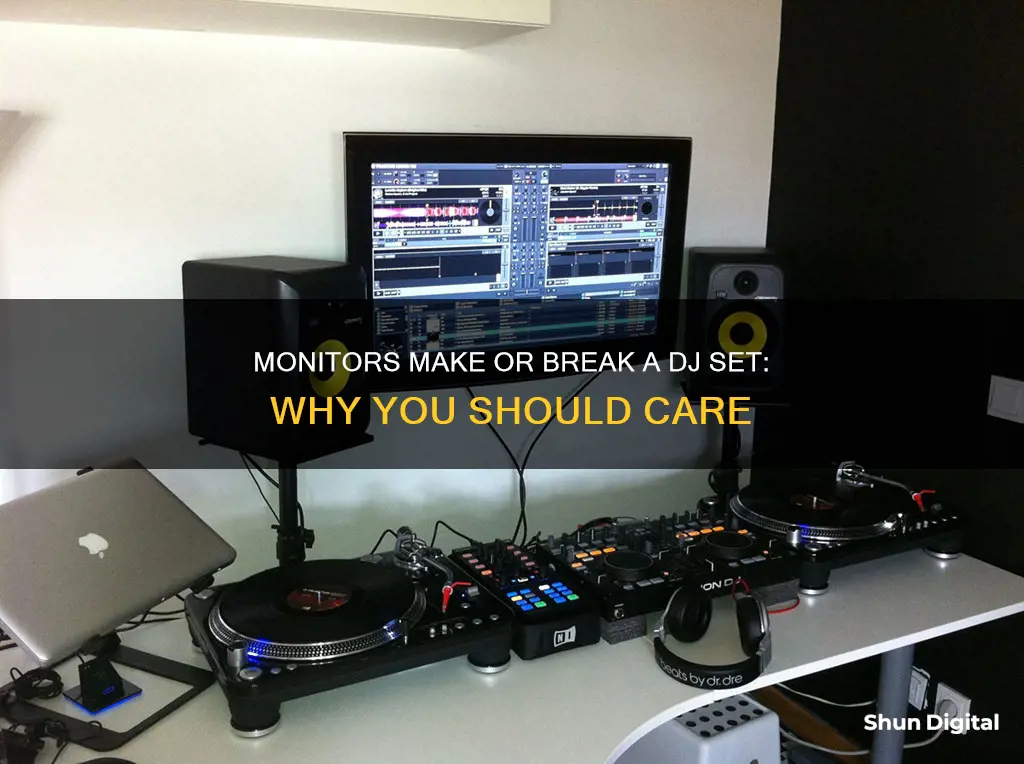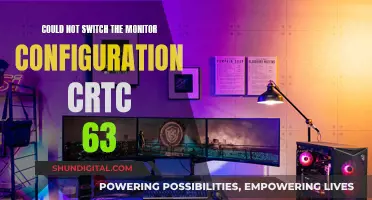
Monitors are an essential part of a DJ setup. They are speakers that face the DJ, providing immediate feedback on the sound that's being sent out to the crowd. This setup is crucial in larger venues where the distance between the DJ booth and the main speakers can create a lag, affecting the DJ's ability to mix tracks seamlessly. Monitors allow DJs to hear their mixes as they are being created, without any delay or interference from room acoustics. This real-time audio feedback is vital for beatmatching and ensuring sound quality.
The choice between passive and active monitors, and between studio monitors and Hi-Fi speakers, is a matter of personal preference and the specific needs of the DJ. Studio monitors are designed to sound neutral, revealing any flaws in production, while Hi-Fi speakers are made to sound good. Active monitors with built-in amplifiers are often favoured for their ease of setup and reliable performance.
Ultimately, the right choice of monitor setup will depend on factors such as budget, space, and the type of music being played.
| Characteristics | Values |
|---|---|
| Purpose | To enable the DJ to hear the mix as they create it |
| Benefit | Provide real-time audio feedback, crucial for DJs |
| Volume Control | Booth monitors can be adjusted independently from the main output |
| Hearing Protection | Prevent hearing fatigue and damage by reducing the need for excessive volume |
| Sound Quality | Ensure the sound is clear, full, and captivating for the audience |
| Speaker Type | Active speakers with built-in amplifiers are commonly used for onstage monitoring |
| Speaker Placement | Speakers should be placed in an equilateral triangle with the DJ's head for optimal sound imaging |
| Speaker Selection | Consider the size of the space, the type of music played, and practical constraints when choosing speakers |
| Speaker Testing | Listen to speakers before purchasing to ensure they meet your specific needs |
| Bluetooth Speakers | Not ideal for DJ monitoring due to latency and lossy transmission |
| Wireless Monitoring | Alternatives like AIAIAI Unit 4 monitors and AlphaTheta Wave-Eight speakers offer low-latency wireless audio |
| Headphones | DJ headphones are essential for cueing and beat matching |
What You'll Learn

Monitors allow DJs to hear their mixes in real-time
Monitors are an essential part of a DJ setup, allowing the DJ to hear their mixes in real-time. They are speakers that face the DJ, providing immediate feedback on the sound being sent to the audience. This is crucial as the main sound system is directed away from the DJ and towards the crowd. Without monitors, the DJ would have to rely on their headphones or the main speakers, which can cause delays and sound distortions that disrupt the synchronization of the tracks being mixed.
The role of monitors is to enable the DJ to hear the mix as they create it, with accuracy and clarity. This is especially important in larger venues or when there is a significant distance between the DJ booth and the main speakers. Monitors provide a direct feed from the DJ mixer, allowing the DJ to make precise adjustments to their mixes in real time. They also help overcome acoustic challenges and ambient noise in the venue, ensuring that the sound quality remains high.
Additionally, monitors allow DJs to adjust the volume independently, creating an intimate and immediate auditory environment. This is crucial for beat-matching and mixing tracks fluidly, as well as protecting the DJ's hearing. With monitors, DJs can prevent the need for excessive volume levels, which can lead to hearing fatigue or damage over time.
The audio quality provided by DJ monitors is essential for EQ and level balancing. A speaker that cannot reproduce low frequencies well may force unnecessary tweaks to the EQ or overall track level. Monitors with a flat response and extended bass can improve mixing and recording quality, ensuring that the DJ's mixes sound consistent across different sound systems.
Blind Spot Monitoring: Standard Feature on All Nissan Rogues?
You may want to see also

Monitors enable DJs to hear their mixes as the audience does
Monitors are an essential part of a DJ's setup, and they serve a crucial function. They enable the DJ to hear the mix as they create it, ensuring that what they are hearing is exactly what the audience is hearing without any delay or sound distortion. This real-time audio feedback is critical for maintaining the energy on the dance floor and for the overall performance quality.
The main sound system in a DJ setup is directed away from the DJ and towards the audience. Without monitors, the DJ would have to rely solely on the main speakers and their headphones to hear their mix, which can lead to challenges with delays and sound distortions that disrupt the synchronization of the tracks. These issues become more pronounced in larger venues or when the DJ booth is at a significant distance from the main speakers.
Monitors, also known as "booth monitors" or "foldback speakers," are speakers that face the DJ, providing immediate feedback on the sound being transmitted to the audience. They are typically smaller speakers that can be adjusted independently from the main output, allowing the DJ to create an intimate and immediate auditory environment. This volume control is essential for effective mixing and protecting the DJ's hearing.
The use of monitors ensures that the DJ hears their mix with as little time delay as possible, making it easier to beatmatch by ear. It also helps overcome acoustic challenges and room acoustics that can interfere with the sound quality. With monitors, DJs can make precise adjustments to their mixes, ensuring that their transitions are smooth and the sound levels are appropriate.
In addition to the standard monitor setup, some DJs also use in-ear monitors (IEMs) to further enhance their monitoring capabilities. IEMs offer superior noise reduction and sound quality, allowing DJs to monitor at lower volume levels and protect their hearing, especially in noisy or challenging acoustic environments.
Ford Maverick: Blind Spot Monitoring Feature Explained
You may want to see also

Monitors help DJs overcome delays and acoustic challenges
Monitors are an essential part of a DJ's setup, helping them to deliver an immersive performance. They are crucial in overcoming delays and acoustic challenges that can disrupt the synchronization of tracks being mixed.
DJs require immediate auditory feedback to ensure seamless transitions between tracks. Without monitors, the sound reaching the DJ's ears is delayed due to the time it takes for sound to bounce off the room's walls. This delay, though subtle, can cause a mix to sound off, making it difficult for DJs to beatmatch by ear.
Monitors, also known as "foldback" speakers, provide an intimate and immediate auditory environment. They are typically positioned to face the DJ, allowing them to hear a direct feed from their mixer. This setup ensures that the DJ hears the mix as it is being created, without interference from room acoustics or ambient noise.
The ability to adjust the volume independently on monitors is advantageous. DJs can create a personal space where the volume is loud enough to override external noise, yet not too loud to cause hearing fatigue or mask the master output. This volume control also helps protect the DJ's hearing, as they don't need to overcompensate with excessive volume levels.
Additionally, the use of monitors helps DJs make precise adjustments to their mixes. They can hear the different elements of the tracks clearly, allowing them to beatmatch, cue, and blend tracks effectively. This clarity is essential for ensuring sound quality and maintaining the energy on the dance floor.
In conclusion, monitors are vital tools for DJs, enabling them to overcome delays and acoustic challenges. They provide accurate and timely feedback, allowing DJs to create seamless and engaging performances for their audiences.
Troubleshooting LCD Monitor: Blinking Issue Explained
You may want to see also

Monitors are essential for accurate beat-matching
Monitors provide real-time audio feedback, allowing DJs to adjust their mixes and ensure sound quality. They are especially important in large venues, where the distance between the DJ booth and the main speakers can create a lag in the music being played and heard. Monitors, placed near the DJ, reduce any perception of delay and enable accurate beat-matching.
The ability to adjust the volume of monitors independently is another advantage. DJs can hear their mix better in a noisy venue and also protect their hearing by turning down the volume when not beat-matching.
Additionally, monitors help DJs overcome acoustic challenges. They enable DJs to hear the mix clearly, regardless of the acoustic imperfections of the venue or ambient noise. This is crucial for beat-matching and creating seamless transitions between tracks.
In conclusion, monitors are vital for DJs to perform accurate beat-matching and deliver a high-quality performance. They provide the necessary audio feedback, reduce delays, and allow for volume control, resulting in an engaging and well-synchronized set.
LCD Monitors: Up-Close Viewing with First-Row Technology
You may want to see also

Monitors help DJs optimise sound for themselves and the audience
Monitors are an essential part of a DJ's setup, helping them optimise sound for themselves and the audience.
DJ monitors, or "foldback" speakers, are speakers that face the DJ, providing immediate feedback on the sound that's being sent out to the crowd. They are crucial in environments where there is a significant distance between the DJ booth and the main PA speakers, which can create a lag between the music being played and heard. This delay can cause issues with synchronisation and disrupt the flow of the performance.
Monitors allow DJs to hear their mix as they create it, without interference from room acoustics or ambient noise. This is essential for beat-matching and mixing tracks seamlessly. With the ability to adjust the volume independently, monitors provide an intimate and immediate auditory environment, preventing the need for excessive volume levels that can lead to hearing fatigue or damage over time.
The audio quality provided by DJ monitors is crucial for EQ and level balancing. A speaker that can't reproduce low frequencies well might force unnecessary EQ adjustments or overall track level changes. It is important to select speakers that offer clear sound reproduction across all frequencies, ensuring every track hits the right notes with the audience.
DJ monitoring typically includes monitor speakers and a pair of DJ headphones. The size and type of speakers depend on the space available and the size of the system the booth needs to compete with in club and festival environments. It is essential to choose the right speakers and amplifiers, considering the venue's size and acoustics to ensure optimal sound quality and volume control.
In conclusion, DJ monitors are vital for optimising sound, allowing DJs to hear their mix accurately and make adjustments in real time, ensuring the audience experiences a high-quality, synchronised performance.
Setting Up Elgato: A Guide to Monitor Connection
You may want to see also
Frequently asked questions
Monitors are important in a DJ setup as they allow the DJ to hear the mix as they create it. Without monitors, the DJ would struggle with delays and sound distortions that could disrupt the synchronization of the tracks being mixed.
Monitors provide real-time audio feedback, which is crucial for DJs. They also help overcome delays and acoustic challenges during performances. Additionally, independent volume control on monitors aids effective mixing and protects the DJ's hearing.
There are two main types of monitors used in a DJ setup: active monitors and passive monitors. Active monitors have built-in amplifiers, while passive monitors require a separate amplifier. Another type of monitor is a subwoofer, which is a large, extra bass speaker. While not essential, it can be beneficial for knowing how your mixes sound with deep bass.
When choosing monitors for your DJ setup, consider the type of music you play. If you play bass-heavy music, size and volume will be more important than if you play music from the 60s. Also, consider the practicalities of your setup, such as the size of the room and any budget constraints. It is recommended to listen to different monitors before purchasing to ensure you are getting the right sound for your needs.







